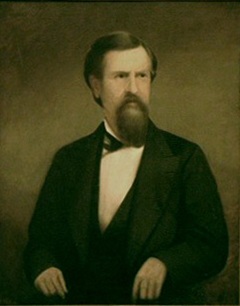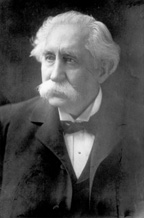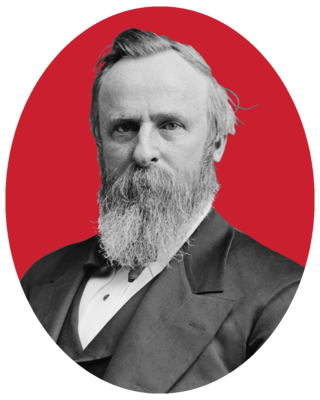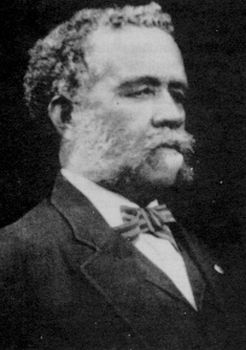
Presidential elections were held in the United States on November 7, 1876. Republican Governor Rutherford B. Hayes of Ohio very narrowly defeated Democrat Governor Samuel J. Tilden of New York. Following President Ulysses S. Grant's decision to retire after his second term, U.S. Representative James G. Blaine emerged as frontrunner for the Republican nomination; however, Blaine was unable to win a majority at the 1876 Republican National Convention, which settled on Hayes as a compromise candidate. The 1876 Democratic National Convention nominated Tilden on the second ballot.

Presidential elections were held in the United States on November 6, 1956. Incumbent Republican President Dwight D. Eisenhower and his running mate, incumbent Vice President Richard Nixon, were reelected, defeating for a second time Democrat Adlai Stevenson II, former Illinois governor. This election was the second time in which the winner was the same both times, the first being William McKinley's victories over William Jennings Bryan in 1896 and 1900. This was the last election before term limits established by the Twenty-second Amendment to the United States Constitution, which first applied to Eisenhower, became effective.

Monroe County is a county in northeast Missouri. As of the 2020 census, the population was 8,666. Its county seat is Paris. It is the birthplace of Mark Twain.

The Solid South was the electoral voting bloc for the Democratic Party in the Southern United States between the end of the Reconstruction era in 1877 and the Civil Rights Act of 1964. During this period, the Democratic Party controlled southern state legislatures and most local, state and federal officeholders in the South were Democrats. During the late 19th century and the early 20th century, Southern Democrats disenfranchised nearly all blacks in all the former states of the Confederate States of America. This resulted in a one-party system, in which a candidate's victory in Democratic primary elections was tantamount to election to the office itself. White primaries were another means that the Democrats used to consolidate their political power, excluding blacks from voting.

James Davis Porter was an American attorney, politician, educator, and officer of the Confederate Army. He served as the 20th Governor of Tennessee from 1875 to 1879. He was subsequently appointed as Assistant Secretary of State during President Grover Cleveland's first administration, and Minister to Chile in Cleveland's second administration.

William Brimage Bate was a planter and slaveholder, Confederate officer, and politician in Tennessee. After the Reconstruction era, he served as the 23rd governor of Tennessee from 1883 to 1887. He was elected to the United States Senate from Tennessee, serving from 1887 until his death.

The 1962 United States Senate elections was an election for the United States Senate. Held on November 6, the 34 seats of Class 3 were contested in regular elections. Special elections were also held to fill vacancies. They occurred in the middle of President John F. Kennedy's term. His Democratic Party made a net gain of four seats from the Republicans, increasing their control of the Senate to 68–32. However, this was reduced to 67–33 between the election and the next Congress, as on November 18, 1962, Democrat Dennis Chávez, who was not up for election that year, died. He was replaced on November 30, 1962, by Republican appointee Edwin L. Mechem. Additionally, Democrat Strom Thurmond became a Republican in 1964, further reducing Democrats to 66–34. This was the first time since 1932 that Democrats gained seats in this class of Senators.

The 1912–13 United States Senate elections were held on various dates in various states. They were the last U.S. Senate elections before the ratification of the Seventeenth Amendment in 1913, establishing direct elections for all Senate seats. Senators had been primarily chosen by state legislatures. Senators were elected over a wide range of time throughout 1912 and 1913, and a seat may have been filled months late or remained vacant due to legislative deadlock. Some states elected their senators directly even before passage of Seventeenth Amendment. Oregon pioneered direct election and experimented with different measures over several years until it succeeded in 1907. Soon after, Nebraska followed suit and laid the foundation for other states to adopt measures reflecting the people's will. By 1912, as many as 29 states elected senators either as nominees of their party's primary or in conjunction with a general election.

The 1876 South Carolina gubernatorial election was held on November 7, 1876, to select the governor of the state of South Carolina. The election campaign was a referendum on the Radical Republican-led state government and their Reconstruction policies. Opponents disputed the challenger Wade Hampton III's victory, gained by a margin of little more than 1100 votes statewide. But he took office in April 1877, after President Hayes withdrew federal troops as a result of a national Democratic compromise, and the incumbent Daniel Henry Chamberlain left the state.

The 1876 Republican National Convention was a presidential nominating convention held at the Exposition Hall in Cincinnati, Ohio on June 14–16, 1876. President Ulysses S. Grant had considered seeking a third term, but with various scandals, a poor economy and heavy Democratic gains in the House of Representatives that led many Republicans to repudiate him, he declined to run. The convention resulted in the nomination of Governor Rutherford B. Hayes of Ohio for president and Representative William A. Wheeler of New York for vice president.

William Francis Yardley was an American attorney, politician and civil rights advocate, operating primarily out of Knoxville, Tennessee, in the late 19th century. He was Tennessee's first African-American gubernatorial candidate, and is believed to have been the first African-American attorney to argue a case before the Tennessee Supreme Court. He published a newspaper, the Examiner, that promoted African-American rights, and was an advocate for labor and the poor both as an attorney and as a politician.

The 1822–23 United States Senate elections were held on various dates in various states. As these U.S. Senate elections were before the ratification of the Seventeenth Amendment in 1913, senators were chosen by state legislatures. Senators were elected over a wide range of time throughout 1822 and 1823, and a seat may have been filled months late or remained vacant due to legislative deadlock. In these elections, terms were up for the senators in Class 2.

The 1930 Pennsylvania gubernatorial election occurred on November 4, 1930. Incumbent Republican governor John Stuchell Fisher was not a candidate for re-election. Republican candidate and former governor Gifford Pinchot defeated Democratic candidate John M. Hemphill to win a second, non-consecutive term as Governor of Pennsylvania.

The 2018 Tennessee gubernatorial election took place on November 6, 2018, to elect the next governor of Tennessee, alongside other state and local elections. Incumbent Republican governor Bill Haslam was term-limited, and is prohibited by the Constitution of Tennessee from seeking a third consecutive term. Republican candidate Bill Lee was elected with 59.6% of the vote, defeating Democratic nominee and former Nashville mayor Karl Dean.

The 1876 United States presidential election in Alabama took place on November 7, 1876, as part of the 1876 presidential election. Alabama voters chose ten representatives, or electors, to the Electoral College, who voted for president and vice president.

The 2022 Tennessee gubernatorial election took place on November 8, 2022, to elect the governor of Tennessee, alongside other state and local elections. Incumbent Republican governor Bill Lee was re-elected to a second term with 64.9% of the vote, defeating his Democratic challenger Jason Martin. Lee improved on his performance from 2018.

The 1898 Tennessee gubernatorial election was held on November 8, 1898. Incumbent Democratic governor Robert Love Taylor did not seek re-election. Democratic nominee Benton McMillin defeated Republican nominee James Alexander Fowler with 57.92% of the vote.

The 1884 Tennessee gubernatorial election was held on November 4, 1884. Incumbent Democratic governor William B. Bate defeated Republican nominee Frank T. Reid with 51.24% of the vote.

The 1876 Illinois gubernatorial election was the sixteenth election for this office. Representative Shelby Moore Cullom narrowly defeated businessman Lewis Steward for the Governorship of Illinois. This was the narrowest victory for a Republican Governor since 1856, when William H. Bissell narrowly won the office in a plurality. Cullom's victory was the sixth consecutive victory for the Republican Party. Cullom also slightly overperformed Republican candidate Rutherford B. Hayes in the concurrent Presidential election.

The 1872 Massachusetts gubernatorial election was held on November 5, 1872. Republican governor William B. Washburn was re-elected to a second term in office over businessman Francis W. Bird, a Liberal Republican nominated with support of the Democratic Party.




















